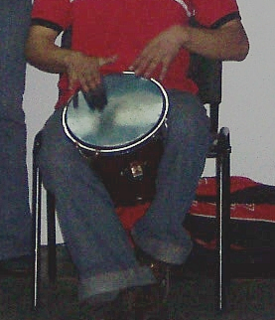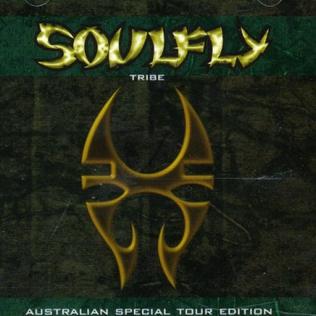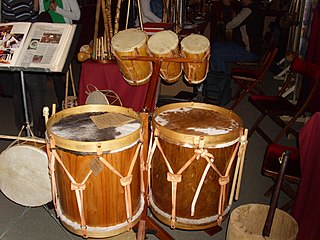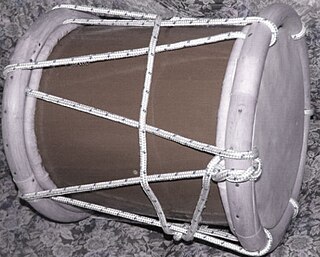
A percussion instrument is a musical instrument that is sounded by being struck or scraped by a beater ; struck, scraped or rubbed by hand; or struck against another similar instrument. The percussion family is believed to include the oldest musical instruments, following the human voice.
The music of the Dominican Republic is primarily influenced by West African, European, and native Taino influences. The Dominican Republic is mainly known for its merengue and bachata music, both of which are the most popular forms of music in the country.
Nortec is a genre of electronic dance music developed in Tijuana that first gained popularity in 2001. Nortec music is characterized by hard dance beats and samples from traditional forms of Mexican music such as Banda sinaloense and Norteño - unmistakably Mexican horns are often used.
A hand drum is any type of drum that is typically played with the bare hand rather than a stick, mallet, hammer, or other type of beater.

Merengue is a type of music and dance originating in the Dominican Republic, which has become a very popular genre throughout Latin America, and also in several major cities in the United States which have Hispanic communities.
Merengue típico is a musical genre of the Dominican Republic, and the oldest style of merengue. Merengue típico is the term preferred by most musicians as it is more respectful and emphasizes the music's traditional nature. The Instruments that are used are the accordion, bass guitar, güira, conga, and tambora (drum)
The term Latin percussion refers to any number of a large family of musical instruments in the percussion, membranophone, lamellophone and/or idiophone family used in Latin music, which in turn is a very loosely related group of musical styles, mainly from the Latin American region, and ultimately having roots or influences in African tribal music.

Banda is a term to designate a style of Mexican music and the musical ensemble in which wind instruments, mostly of brass and percussion, are performed.

The güira is a metal scraper from the Dominican Republic used as a percussion instrument in cumbia and merengue, to a lesser extent, other genres such as bachata. It is made of a metal sheet and played with a stiff brush, thus being similar to the Cuban guayo and the güiro. Güira, guayo and güiro all have a function akin to that of the maracas or the trap-kit's hi-hat, namely providing a complementary beat.

Duranguense is a subgenre of Regional Mexican music. It surged to large-scale popularity during the mid 2000’s among the Chicano community in the United States, as well as in Mexico. The main instruments are the saxophone, trombone, synthesizer and tambora. Among the Duranguense elements carried over from other genres is el tamborazo; a heavy percussion line consisting of the bass drum and varied snare drum rolls. This genre popularized the dance style, Pasito Durangense.

The caja, a drum similar to a tambora, is one of the three main or traditional instruments of the Vallenato music. Caja, the slang word adopted to nickname this drum, means "box" in Spanish. There is also a Caribbean drum called caja, used in the music of Colombia.
Tatico Henríquez, considered one of the best accordionists of merengue tipico, was born in Nagua, Dominican Republic. His career began in the 1960s and the early 1970s. He was known for his skill on the accordion and the addition of new instruments to a standard merengue tipico band.

Tribe is an extended play from the metal band Soulfly. The EP was released in Australia.
Tamborera is a genre of Panamanian folk music. It is a mixture of Panamanian Tamborito and Cuban Danzón, created by the musician Ricardo Fabrega during the first half of the twentieth century.

The bombo criollo, or simply bombo, is a family of Latin American drums derived from the European bass drum and native Latin American drum traditions. These drums are of smaller dimensions than the orchestral bass drum, and their frame can be made of wood or steel. They can be held vertically or diagonally on the body or a stand. The specific make of the instrument depends on the regional tradition. In Argentina, the bombo criollo is called bombo legüero. In Cuba, it is known as bombo de comparsa due to its use in comparsas. In other countries, the term tambora is commonly used.
Meren(gue)house/Merenrap is a hip hop music style formed by blending Dominican merengue music with rap, dancehall reggae and hip hop. The group Proyecto Uno pioneered the genre. Merenhouse usually combines a rap style of singing (talk-singing) with actual singing. It has instruments that are typically in merengue music, such as saxophones, trumpets, accordion, bass, guitar, güira, tambora (drum). However, they can be combined with electronic sounds or even electronic sounds sampled from the actual instruments. Sampling music means to take a sample or portion of a sound recording to reuse it in a song. Merenhouse is very upbeat for dancing, like house music. It is hard to identify merenhouse based on its time signature and rhythm alone. Some merenhouse music is in a fast 2/4 beat and has typical merengue style rhythms. Some also is in a slower 4/4 beat, identifying more with the hip hop style. Merenhouse can be characterized mostly by the instruments/electronics used and the combination of vocal styles.








